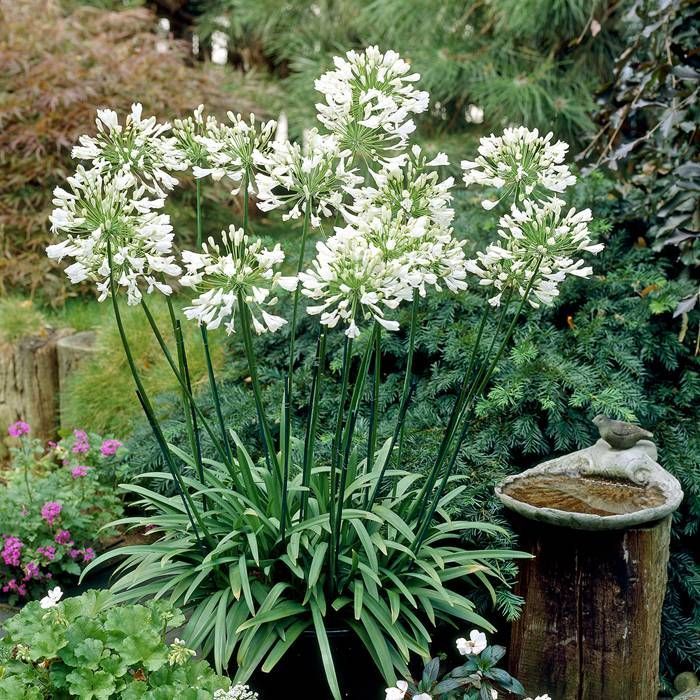Spectacular Agapanthus: Enhancing Your Yard's Appeal
Understanding the Art of Agapanthus Treatment: Crucial Actions for Healthy Development and Vivid Flowers
In the world of horticulture, the growing of agapanthus stands as a gratifying endeavor for those who seek to nurture these stylish blooming plants. From choosing the ideal range to grasping trimming techniques, the trip in the direction of growing prospering agapanthus plants is diverse and holds the vital to unlocking the full capacity of these agricultural treasures.

Picking the Right Agapanthus Selection

When choosing the best Agapanthus range for your garden, take into consideration variables such as climate suitability, flower color, and growth practice. Agapanthus, frequently understood as Lily of the Nile or African lily, is available in a selection of colors varying from shades of blue and purple to white. Choose a bloom shade that enhances your existing garden scheme to produce an unified landscape. Furthermore, consider the climate in your area to ensure the Agapanthus selection you choose can grow in your specific conditions. Some ranges are more forgiving of chilly temperature levels, while others favor warmer environments. Comprehending the development behavior of various Agapanthus varieties is vital for proper placement within your garden. Some selections have a clumping development behavior, ideal for containers or boundaries, while others have an even more dispersing nature, appropriate for ground cover or mass plantings. By thoroughly examining these aspects, you can select the excellent Agapanthus range to boost the charm of your garden.
Perfect Growing Conditions
Considering the optimal ecological demands is vital for successful Agapanthus farming. Agapanthus prospers in well-draining dirt with a somewhat acidic to neutral pH level. When planting, pick a place that gets complete sunlight to partial color. In hotter climates, giving some afternoon shade can protect against scorching of the leaves. Agapanthus plants are sensitive to chilly temperatures and must be safeguarded from frost throughout cold weather.
To ensure healthy development and vivid flowers, plant Agapanthus light bulbs at a depth of concerning 2-4 inches and area them 8-12 inches apart. Adding organic issue, such as garden compost, to the dirt can boost drain and fertility, advertising robust origin advancement. Mulching around the base of the plants assists retain moisture and reduces weed growth. Normal watering is crucial, particularly during the expanding season, to keep the dirt continually wet but not waterlogged.
Watering and Feeding Tips
Maintaining correct moisture degrees and offering important nutrients are essential elements in the treatment program for Agapanthus plants. When it comes to sprinkling Agapanthus, it is vital to strike a balance. These plants favor consistently wet dirt however are prone to root rot if overwatered.
Fertilizing Agapanthus is important for advertising healthy and balanced growth and prolific flowers. Apply a well balanced plant food, such as about his a 10-10-10 formula, in the very early spring as new development emerges. Repeat this application every 6-8 weeks throughout the expanding season. Prevent too much fertilizing, as it can bring about lush vegetation at the cost of flowers. Constantly adhere to the producer's directions for proper dilution and application methods. By following these watering and feeding pointers, you can guarantee your Agapanthus plants prosper and generate dynamic, long-lasting blossoms.
Pruning Strategies for Agapanthus
Pruning Agapanthus plants at the suitable times and with proper techniques is crucial for maintaining their Discover More health and advertising optimum development and blooming. The perfect time to prune Agapanthus remains in late winter months or very early spring before brand-new development arises. Start by removing any dead or yellowing fallen leaves near the base of the plant. Cut them as close to the ground as feasible without harming the emerging see this page shoots.
Deadheading spent flowers can likewise reroute the plant's energy into generating even more blooms rather than setting seeds. If you want to collect seeds for breeding, leave some blossoms to completely dry and fully grown on the plant.
Bear in mind to make use of tidy, sharp tools to make precise cuts and decrease the risk of introducing conditions. Agapanthus. Normal pruning will certainly assist maintain your Agapanthus looking healthy and cool while guaranteeing a bountiful display of beautiful flowers
Managing Usual Bugs and Diseases
After making sure appropriate trimming techniques for Agapanthus, it is crucial to attend to common bugs and diseases that can influence the wellness and vitality of these plants. One typical insect that affects Agapanthus is the Agapanthus gall midge.
One more common concern is fungal leaf spot, which offers as dark sores on the fallen leaves. To stop fungal conditions, make sure excellent air blood circulation around the plants, avoid above watering, and eliminate any kind of contaminated leaves quickly. Furthermore, Agapanthus plants can experience origin rot if they are planted in inadequately draining soil. To stop this, plant Agapanthus in well-draining dirt and prevent overwatering. By being attentive and taking timely action versus insects and illness, you can help your Agapanthus plants prosper and create dynamic blossoms.

Verdict
To conclude, grasping the art of agapanthus care involves selecting the best variety, providing perfect planting problems, correct watering and feeding, proper pruning methods, and attending to common parasites and conditions. By adhering to these essential actions, you can guarantee healthy growth and vivid blossoms for your agapanthus plants. Keep in mind to regularly monitor and maintain your plants to promote their total wellness and long life.
To make sure healthy development and dynamic blossoms, plant Agapanthus light bulbs at a depth of regarding 2-4 inches and room them 8-12 inches apart. By adhering to these watering and fertilizing pointers, you can guarantee your Agapanthus plants grow and create vivid, resilient blooms.
One common parasite that influences Agapanthus is the Agapanthus gall midget. Additionally, Agapanthus plants can experience from origin rot if they are grown in improperly draining pipes soil. By adhering to these necessary actions, you can ensure healthy development and dynamic blooms for your agapanthus plants.